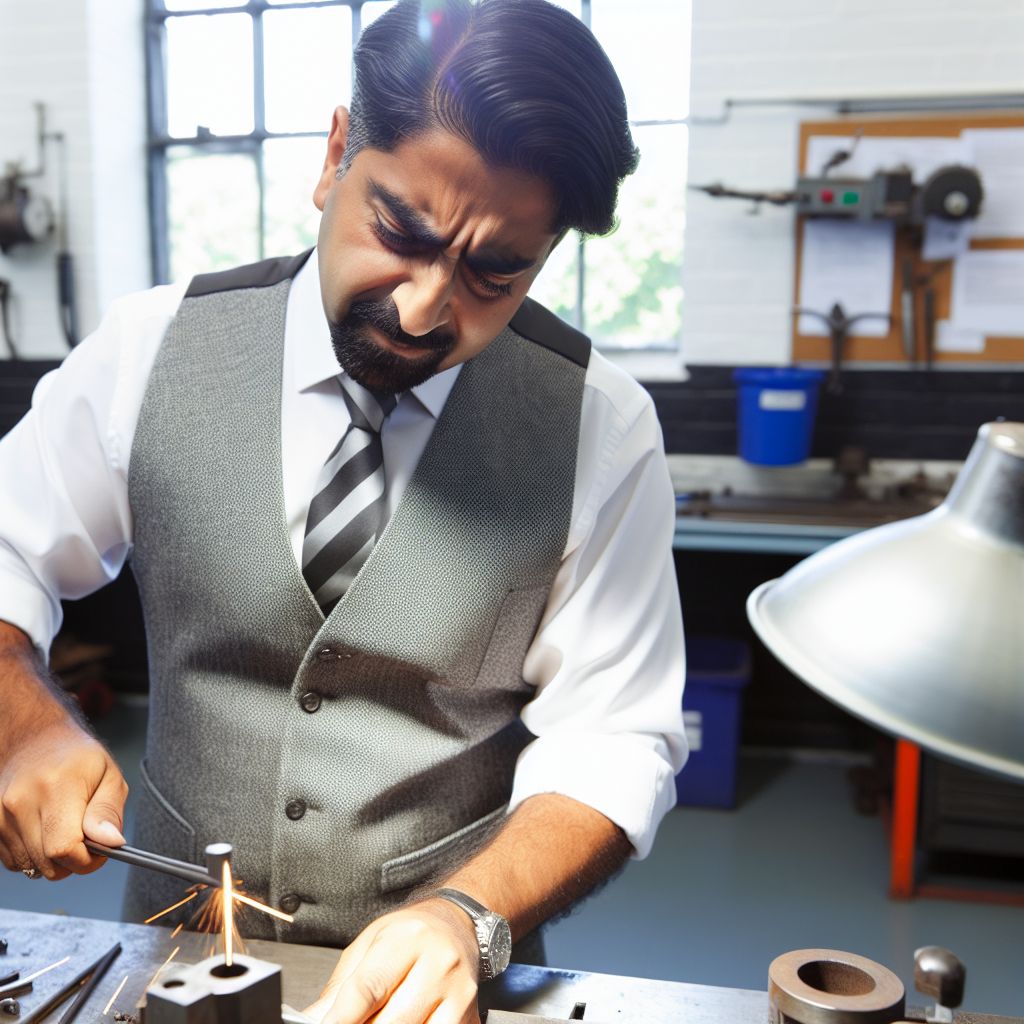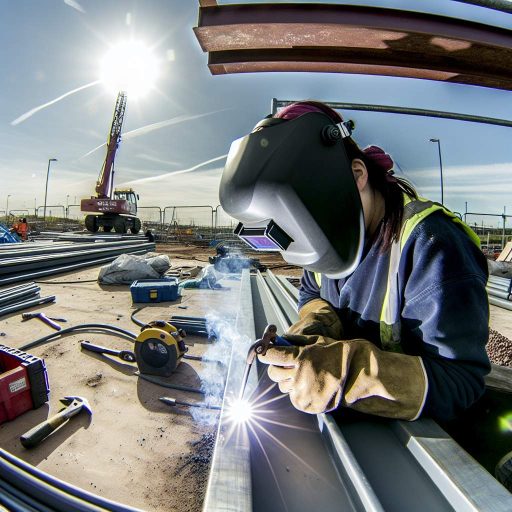Introduction to Metal Fabrication
Definition and Importance
Metal fabrication involves creating metal structures through cutting, bending, and assembling processes.
This craft plays a crucial role in various industries, including construction, automotive, and aerospace.
Additionally, it encompasses both custom projects and mass production techniques.
Skilled fabricators use a range of tools like lasers, CNC machines, and welding equipment.
Moreover, they ensure precision and quality in every project they undertake.
Applications of Metal Fabrication
Metal fabrication serves many vital applications in today’s world.
For instance, it is essential in manufacturing machinery parts that are critical for various operations.
Furthermore, metalworkers create structural beams and frames for buildings and bridges.
Also, they produce components for consumer products such as electronics and furniture.
The Role of Technology in Metal Fabrication
Modern technology significantly enhances metal fabrication processes.
For example, advanced software streamlines design and drafting.
Additionally, automated machines increase speed and accuracy in production.
These technologies also help reduce waste and improve safety on the shop floor.
Consequently, the industry continuously evolves to meet changing demands.
Career Opportunities in Metal Fabrication
The field of metal fabrication offers numerous career opportunities.
Personalized UK Career Consulting
Receive tailored career guidance designed just for you. Get actionable steps and expert support to boost your career in 1-3 days. Take control of your career now.
Get StartedIndividuals can become welders, machinists, or sheet metal workers.
Additionally, roles in design and engineering are also available in this field.
Vocational training programs and apprenticeships provide essential hands-on experience.
Ultimately, skilled fabricators are in high demand across various sectors.
Overview of Different Metal Fabrication Techniques
Welding Techniques
Welding unites metal pieces through heat and pressure.
This technique is essential in various industries.
Common welding methods include MIG, TIG, and Stick welding.
MIG welding offers speed and versatility.
TIG welding delivers precision and control.
Stick welding is highly portable and easy to use.
Cutting Methods
Metal cutting is crucial for shaping pieces effectively.
Several cutting methods exist in metal fabrication.
Plasma cutting utilizes high-velocity plasma to cut metal.
Laser cutting offers precision with reduced material waste.
Your Dream Job Starts with a Perfect CV
Get a tailored CV and cover letter that captures your unique strengths and stands out in your industry. Let us help you make an unforgettable first impression.
Get StartedShearing is another method, ideal for straight cuts.
Bending Techniques
Bending transforms flat metal sheets into shaped components.
Press brakes are commonly used for effective bending.
Different angles and radii can be achieved with bending techniques.
This process requires accuracy to meet specifications.
Machining Processes
CNC machining automates precision fabrication tasks.
Turning and milling are two common machining processes.
These techniques allow for fine-tuning of dimensions.
Assembly and Finishing
Assembly joins various fabricated parts into final products.
This step often involves additional techniques such as welding or fastening.
Finishing processes improve appearance and durability.
Coating, polishing, and painting are common finishing methods.
Each technique enhances the product’s functionality and aesthetics.
Optimize Your LinkedIn for Success
Boost your LinkedIn profile with a professional bio, keyword-rich headline, and strategic recommendations that attract recruiters. Stand out from the crowd and get noticed.
Optimize NowEssential Skills Required for a Career in Metal Fabrication
Technical Proficiency
Metal fabrication demands strong technical skills in various processes.
Welding, machining, and cutting are fundamental techniques.
Professionals must understand blueprints and technical drawings.
Mastering these skills enhances productivity and accuracy.
Mathematical Skills
Math skills are crucial in metal fabrication jobs.
Workers use mathematics for measuring and cutting materials.
Familiarity with geometry helps in understanding shapes and spaces.
Additionally, calculations aid in cost estimation and resource management.
Problem-Solving Ability
Problem-solving is vital in the fabrication field.
Challenges often arise during production processes.
Practitioners must think critically to devise effective solutions.
Adaptability plays a crucial role when unexpected situations emerge.
Attention to Detail
Attention to detail ensures high-quality outputs in metal fabrication.
Small errors can lead to significant cost overruns or safety issues.
Workers must inspect their work meticulously at each stage.
Thorough inspections reduce the likelihood of defects.
Physical Stamina and Strength
Metal fabrication involves physical demands on the workforce.
Workers often handle heavy materials and operate machinery.
Physical stamina helps with long hours in challenging environments.
Moreover, strength is essential for lifting and positioning large parts.
Team Collaboration
Collaboration is important for smooth operations in fabrication settings.
Metal workers often team up to complete complex projects.
Effective communication fosters a cooperative work environment.
Teamwork enhances both efficiency and productivity across tasks.
Safety Awareness
Understanding safety protocols is crucial within the fabrication industry.
Workers must familiarize themselves with equipment safety measures.
Personal protective equipment (PPE) is an essential part of daily wear.
Awareness of hazards minimizes the risk of accidents on the job.
Uncover the Details: How Painters and Decorators Transform Living Spaces
Educational Pathways and Training Programs in Metal Fabrication
Overview of Metal Fabrication Education
Metal fabrication requires specialized knowledge and skills.
A variety of educational pathways exist to support aspiring professionals.
These programs combine theory with hands-on training.
High School Programs
Many high schools offer vocational courses in metalworking.
Students can gain early exposure to tool use and safety practices.
These programs often include welding, machining, and fabrication techniques.
Participation can enhance college and job applications.
Community Colleges and Trade Schools
Community colleges provide comprehensive metal fabrication programs.
These programs lead to associate degrees or certificates.
Topics covered include metallurgy, welding, and CAD design.
Trade schools focus intensely on practical skills in a shorter timeframe.
Apprenticeships
Apprenticeships combine paid work with classroom instruction.
Apprentices gain valuable real-world experience while learning.
Many apprenticeship programs partner with unions and companies.
They often lead to well-paying jobs after completion.
Certification Programs
Certification enhances job prospects in metal fabrication.
Organizations like the American Welding Society offer credentials.
Certification validates skills in welding, fabrication, and safety.
Employers often seek certified professionals for their expertise.
Continuing Education
Continuing education opportunities are available for professionals.
Workshops and seminars help keep skills current.
New technologies frequently emerge in the fabrication industry.
Staying updated is crucial for career advancement.
Online Learning Resources
Online courses offer flexibility for busy professionals.
Many platforms provide classes on specific fabrication techniques.
This can be a cost-effective way to enhance skills.
Virtual simulations can replicate real-world fabrication scenarios.
Explore Further: Reskilling for the Future: UK Trade Careers in Renewable Energy
Job Opportunities and Career Paths in Metal Fabrication
Overview of Job Opportunities
The metal fabrication industry offers various career options.
Graduates can find roles in manufacturing, construction, and repair services.
Common job titles include metal fabricator, welder, and machinist.
These positions require a blend of skills and technical knowledge.
Job seekers will benefit from hands-on experience and training programs.
Career Paths in Metal Fabrication
A typical career in metal fabrication begins with an entry-level position.
Many start as apprentices or assistants to experienced fabricators.
As they gain skills, they can advance to specialized roles.
Specialization may involve welding techniques, CNC machining, or design.
Advancement to Supervisory Roles
With experience, fabricators may move into supervisory positions.
In these roles, they oversee production processes and manage teams.
A strong understanding of operations is crucial for success.
Opportunities in Management
Some professionals choose a career path in management.
Operations managers coordinate daily activities and ensure efficiency.
Management roles often require additional training and leadership skills.
Impact of Certifications on Career Progression
Certifications can significantly enhance job prospects in metal fabrication.
Industry-recognized certifications validate skills and knowledge.
Professionals with certifications often command higher salaries.
Popular certifications include those offered by the American Welding Society.
Emerging Trends and Innovations
The metal fabrication industry evolves with technology and innovation.
New techniques, such as 3D printing, are transforming the field.
Workers skilled in these technologies will be in high demand.
Staying updated with industry trends can provide a competitive edge.
Explore Further: In-Demand UK Trade Skills for 2024: Which Ones Are Set to Thrive?

The Role of Technology in Modern Metal Fabrication
Advancements in Machinery
Recent innovations in machinery have transformed metal fabrication processes.
High-precision CNC machines enable accurate cutting and shaping of metals.
Additionally, automation reduces human error and increases efficiency.
As a result, fabricators can meet tight production schedules.
Software Integration
Modern metal fabrication relies heavily on software integration.
CAD software allows designers to create detailed 3D models.
This technology simplifies the transition from design to production.
Moreover, advanced simulation software optimizes cutting paths.
Such tools significantly decrease waste and improve resource management.
Adoption of Welding Technologies
Welding technologies have also evolved dramatically.
Laser welding provides precise joins with minimal heat distortion.
TIG and MIG welding techniques enhance versatility in various projects.
These advancements promote higher quality and durability in finished products.
Benefits of Smart Manufacturing
Smart manufacturing integrates IoT devices into the fabrication process.
These systems monitor production lines in real-time.
Consequently, they identify bottlenecks and optimize workflows.
Data analytics also inform decision-making, enhancing overall productivity.
Workforce Training and Adaptation
Technology requires ongoing workforce training for effective adoption.
Companies invest in upskilling employees in modern techniques.
Furthermore, technicians must understand software and machinery functionalities.
This ensures a competent workforce capable of utilizing advanced technologies.
Find Out More: Why Electrical Engineering Apprenticeships Are the Smartest Career Move for Young Britons
Workplace Safety Standards and Regulations in Metal Fabrication
Importance of Safety Standards
Safety standards play a crucial role in metal fabrication workplaces.
They help protect workers from potential hazards.
Furthermore, these standards maintain a safe work environment.
Common Safety Regulations
Numerous regulations govern safety in metal fabrication.
Occupational Safety and Health Administration (OSHA) sets benchmarks for safety practices.
Moreover, local regulations may impose additional requirements.
Hazard Communication
Employers must inform workers about hazardous materials.
This includes labels, safety data sheets, and training.
Clear communication is vital to prevent accidents.
Personal Protective Equipment (PPE)
Using proper PPE is essential in metal fabrication.
Workers should wear helmets, gloves, and eye protection.
Additionally, respiratory protection may be necessary.
Regular Safety Training
Providing regular safety training enhances worker awareness.
This training should cover emergency procedures and equipment handling.
Ultimately, an informed workforce reduces risks.
Workplace Inspections
Conducting regular workplace inspections is necessary.
These inspections identify potential hazards and ensure compliance.
Furthermore, they promote a culture of safety among workers.
Response to Incidents
A clear response plan for safety incidents is critical.
This plan should outline steps for dealing with accidents.
Additionally, it should include procedures for injury reporting.
Future Trends and Innovations in the Metal Fabrication Industry
Adoption of Advanced Technologies
The metal fabrication industry increasingly relies on advanced technologies.
Robotics and automation streamline production processes.
Additionally, 3D printing revolutionizes custom part design.
These technologies enhance precision and efficiency in operations.
Material Developments
Innovations in materials are transforming fabrication practices.
New alloys and composites offer improved performance and durability.
These materials reduce weight while maintaining strength.
Moreover, sustainable materials gain traction in manufacturing processes.
Green Manufacturing Practices
Environmental sustainability is a growing focus in metal fabrication.
Companies are adopting eco-friendly methods and materials.
Energy-efficient machinery reduces carbon footprints substantially.
Companies also seek ways to minimize waste through recycling.
Customization and Flexibility
There’s a rising demand for customized metal products.
Fabricators are leveraging technology to meet specific client needs.
This shift enhances product differentiation in competitive markets.
Flexibility in production lines allows rapid responses to market changes.
Skills Development and Workforce Innovation
The future of metal fabrication relies on skilled workers.
Training programs evolve to meet industry demands.
Additionally, collaboration between academia and industry promotes innovation.
Investing in workforce skills ensures sustainability in the field.
Additional Resources
What is a career that uses your hands, but doesnt kill your body? : r …
[E-Book for Sale]
500 Cutting-Edge Tech Startup Ideas for 2024 & 2025: Innovate, Create, Dominate
$19.99 • 500 Tech Startup Ideas • 62 pages
You will get inspired with 500 innovative tech startup ideas for 2024 and 2025, complete with concise descriptions to help you kickstart your entrepreneurial journey in AI, Blockchain, IoT, Fintech, and AR/VR.




